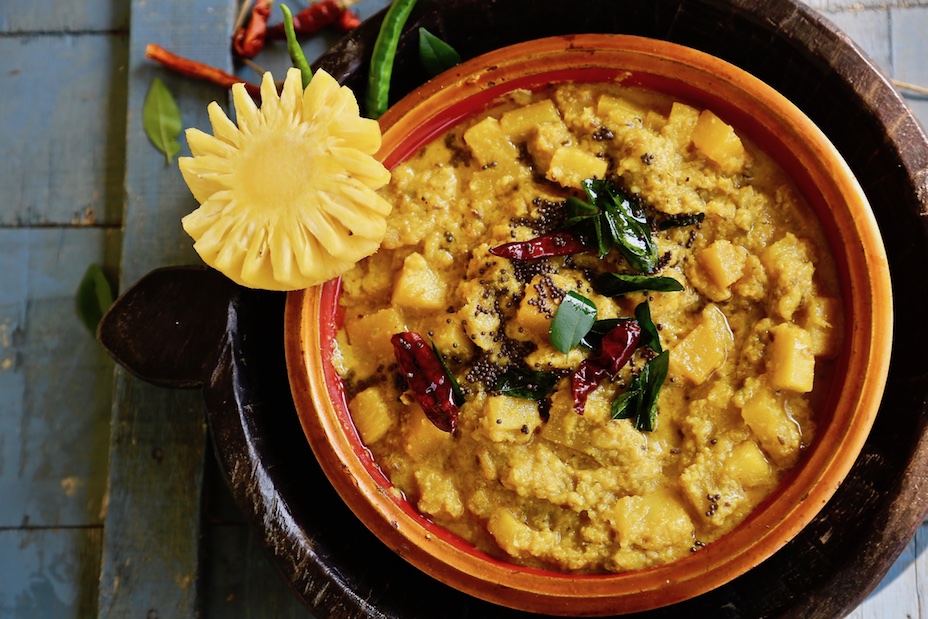
Local food is easy to take for granted, and you only really notice after you leave. While living on the backwaters of Cochin, it never once occurred to me to take a cooking class. Great seafood was available through native cooks and restaurants at reasonable prices whenever my stomach desired. But once I moved to Mumbai, I realized local food is best eaten locally, unless you really learn the techniques and source the ingredients that give those meals their flavour.

Recently, a student of mine from Cochin did something special – upon hearing of my upcoming travel to the city, he booked a cooking class with a chef at a nearby restaurant in Fort Kochi. Unfortunately, I fell ill, and couldn’t attend. However, last month, I was finally able to meet up with the same chef, Chef Benny Thomas, of the popular restaurants in Cochin – Oceanos and Fusion Bay – and spend a few hours in his kitchen.

While Chef Benny chatted away in Malayalam with my friend Saritha, I uncertainly followed, only patchily understanding his language, and interrupting with hundreds of questions when he switched to English. “Why do you cook the prawns for so long? Don’t they get hard?” – Chef Benny explained that the chance of food poisoning was high in the old days, so they were sometimes cooked for hours. Food was also left out the whole day, so this measure ensured it was safe to eat. He advised me not to add tamarind or coconut milk to prawns that are going to be refrigerated, to prevent chances of spoilage. I noticed he was using tomatoes in both his fish preparations as well as prawns, and tomatoes are not native to Kerala. In fact, his fish had what looked like a sofrito as the base of its sauce. Chef Benny noted, “Tomatoes were brought to India by the Portuguese, and chilies were introduced to India by Vasco de Gama from Africa in the 15th century. Until then, Kerala food was mainly flavored with coconut, black pepper, curry leaves, ginger and other local spices like turmeric, cardamom and cinnamon.” Personally, I still prefer the humble additions of just pepper and curry leaves to seafood cooked in coconut oil.
Since I quickly jotted Chef Benny’s recipes while he was cooking, I’ve adapted them a bit to make them easier. My two favourites – the Prawn Curry with Kokum and the Pumkin and Fruit kichadi – are below, with some short videos from our kitchen sessions.
Prawn Curry with Kokum
Ingredients
350g-400g / about 20 pieces medium-large prawns, cleaned deveined (without shell)
1” piece of ginger, chopped
6 cloves garlic, roughly chopped
1 small onion (about 3” diameter), sliced thinly
3 tomatoes, pureed (about 1 cup puree)
1½ teaspoons salt
1 teaspoon turmeric powder
¼th teaspoon chili powder, or to taste
1 teaspoon Kashmiri chili powder
8-10 curry leaves
2 pieces dried kokum (garcinia fruit)
½ cup water
1 small raw mango, roughly peeled, stoned, and cut into 1” pieces (about 100g)
2 cups thin coconut milk
2 tablespoons coconut oil
Method
Soak kokum in ½ cup water. Keep aside while preparing vegetables/mango for cooking.
Heat oil in a frying pan on medium heat, add onion and fry for one minute. Add ginger and garlic, and fry until the bits start changing color to a golden brown (2-3 minutes).
Add half the pureed tomatoes, the salt, turmeric, chili powder and Kashmiri chili powder. Raise heat to high and bring the curry to a boil.
Add ½ the coconut milk (1 cup), and boil the curry for 2 minutes, stirring continuously. After two minutes, add the remaining tomato puree, coconut milk and the curry leaves, again bring to a boil and thicken for 2 minutes, stirring until you have a nicely emulsified curry.
Add prawns, raw mango, and kokum water (discard the kokum). Lower heat to medium, keeping curry on a ow boil and stirring occasionally. Allow to cook for 15-18 minutes until you get a thickened smooth curry
Serve hot with rice or chapattis.
Serves: 2-4 people as part of a meal
Ingredients: 14

Critical Ingredients:
If you do not Kashmiri chili powder, substitute the 1 teaspoon with ¼th teaspoon chili powder and 1½ teaspoons paprika. The curry leaves are a critical flavor, but the curry will taste good even without them. Coconut oil also gives the dish flavor, but if you don’t have it substitute any vegetable oil. If you don’t have both ginger and garlic, use at least one of the two. If kokum is not available, leave it out, as it is more for flavor than acidity.

I am also a big fan of fruit curries, and I absolutely loved Chef Benny’s Pumpkin and Pineapple “kichadi”. Not the North Indian kichadi – which made of rice and dal – but a chutney-like dish that is served on the side of a large, traditional Kerala meal. I’d love to just eat it plain as it is! While checking the difference between a pachadi and a kichadi in Kerala food, all I understand that the vegetable/fruit in a pachadi is usually boiled, while in a kichadi is fried in coconut oil/ghee. For an easy pachadi recipe, try this Ripe Mango Pachadi.
Kerala Pumpkin Pineapple and Banana Curry
Ingredients
1 cup diced pumpkin (about 150g)
1 cup of diced pineapple (about 150g – this about a third of a small ripe pineapple, peel cut and core into half inch cubes. If using canned pineapple, cut rings into 1/2” pieces)
1 cooking banana, semi-ripe, cut into ½ inches circle and halved (about 1 cup or 150g)
¾th teaspoon salt
½ teaspoon Kashmiri chili powder, or to taste
1 teaspoon sugar (optional)
½ cup grated fresh coconut, or about 4 tablespoons
½ teaspoon turmeric
½ teaspoon cumin seed
1 whole green chili
½ cup water
1 cup fresh plain yoghurt
½ cup water
1 teaspoon mustard seeds
5-6 fresh or dried curry leaves
2-3 dry red chilies
3 tablespoons ghee – divided into two
Method
Heat 2 tablespoons of the ghee in a wok or a 9 inch frying pan on medium heat. Add pineapple and cook, stirring occasionally for 3-4 minutes.
Add the pumpkin, the banana, salt, and Kashmiri chili powder, and cook uncovered raising heat to high, for about 6 minutes, stirring continuously.
Grind coconut, cumin, turmeric and chili with ½ cup water in a grinder or food processor for about ½ minute until well blended. Add to fruit and cook for a minute.
Beat or whisk yoghurt with ½ cup of water until smooth. Add to curry. Allow to cook on a slow boil on medium heat, stirring occasionally, for about 15 minutes. Curry is done when pumpkin and pineapple pieces are tender.
Heat remaining ghee on medium heat in a small frying pan. Add mustard seeds.
When the mustard starts to sizzle and pop, add curry leaves and whole dried red chilies, and stir, about 2 minutes.
Pour the tempered ghee with the leaves and chilies into your curry pot.
Serve at warm with rice, or as a side dish with any meal.
Serves: 4-6 as a side
Ingredients: 15
Critical Ingredients: The pumpkin and pineapple of course, are critical. If you are using a ripe green banana instead of a cooking banana, add it only at along with the coconut paste and not earlier, as the curry will get very mushy. If you use dried (not sweetened) or desiccated coconut, soak it in milk for ½ hour in advance. Yoghurt, coconut and turmeric are critical. You can add ½ a teaspoon of red chili powder instead of the green chili. If you leave out the curry leaves you won’t get full authentic flavor, but you will still have a nice sweet, sour, spicy side dish. Ghee gives the curry richness and complements the sweetness of the pumpkin and fruit. Coconut oil works well too, but you can substitute the ghee with any mild-flavored oil for frying and tempering.





